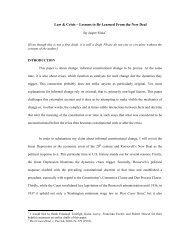updating brignoni-ponce - New York University School of Law
updating brignoni-ponce - New York University School of Law
updating brignoni-ponce - New York University School of Law
Create successful ePaper yourself
Turn your PDF publications into a flip-book with our unique Google optimized e-Paper software.
2008] UPDATING BRIGNONI-PONCE 605<br />
grants are not eligible for federal public benefits such as income<br />
supplements, health care, and food stamps. 239 Most immigrants come<br />
to the United States because there is demand for their services, and<br />
they do not displace American citizen workers. 240 Immigrants <strong>of</strong>ten<br />
fill low-skilled, low-cost jobs that many American citizens will not<br />
even consider taking. 241 Since immigration laws make obtaining the<br />
correct documents extremely difficult, the result is that most immigrants<br />
who want to come to the United States must enter illegally and<br />
live in the shadows <strong>of</strong> society since they lack proper<br />
documentation. 242<br />
Seeing undocumented immigrants only as creating significant economic<br />
and social problems ignores U.S. policy that has encouraged<br />
immigration to the United States while limiting the access to legal<br />
status. 243 This also ignores the benefits that the United States receives<br />
239. NAT’L IMMIGRATION LAW CTR., FACTS ABOUT IMMIGRANTS’ LOW USE OF<br />
HEALTH SERVICES AND PUBLIC BENEFITS 3 (2006), available at http://www.nilc.org/<br />
immspbs/research/imms&publicservices_2006-9-12.pdf. The claim that immigrants<br />
are responsible for high rates <strong>of</strong> emergency room usage is contradicted by research<br />
showing that communities with high rates tend to have relatively small percentages <strong>of</strong><br />
noncitizen residents. Id. at 1.<br />
240. For example, between 2000 and 2020 the United States will not have a net<br />
increase in native-born workers aged 25 to 54, and immigrant workers will need to fill<br />
this “worker gap.” See IMMIGRATION AND AMERICA’S FUTURE, supra note 235, at 3. R<br />
241. Plyler v. Doe, 457 U.S. 202, 228 (1981) (noting no credible evidence supporting<br />
argument that children are burden on economy and recognizing that immigrants<br />
are attracted to the United States by the availability <strong>of</strong> employment which results in<br />
labor for the local economy and tax money for the state); Hernández-Truyol, supra<br />
note 82, at 264; Perea, supra note 61, at 2 (“For a chance at a better life, the undocu- R<br />
mented are willing to work hard for much less than they deserve.”).<br />
242. One example <strong>of</strong> this difficulty is the caps that limit each country to no more<br />
than 7%, approximately 25,600, <strong>of</strong> the total number <strong>of</strong> annual worldwide visas. IMMI-<br />
GRATION AND AMERICA’S FUTURE, supra note 235, at 22; supra notes 125–26 and R<br />
accompanying text. Because <strong>of</strong> these caps, a U.S. citizen sponsoring an unmarried<br />
child from Mexico is likely to wait fourteen years for unification, and a legal permanent<br />
resident sponsoring a spouse can expect to wait six years regardless <strong>of</strong> country <strong>of</strong><br />
origin. IMMIGRATION AND AMERICA’S FUTURE, supra note 235, at 22. R<br />
243. See United States v. Brignoni-Ponce, 422 U.S. 873, 878–79 (1975). One such<br />
policy was the government-sponsored Bracero Program <strong>of</strong> the 1940s–60s, which facilitated<br />
the migration <strong>of</strong> Mexican workers to the United States. Tallman, supra note<br />
38, at 884. These economic issues are complicated and out <strong>of</strong> the scope <strong>of</strong> this paper. R<br />
Suffice it to note that focusing on a particular immigrant’s decision to immigrate to<br />
the U.S. puts all the responsibility for immigration on the immigrants. See SASKIA<br />
SASSEN, LOSING CONTROL?: SOVEREIGNTY IN AN AGE OF GLOBALIZATION 84 (1996).<br />
This allows commentators to speak about the United States passively receiving an<br />
“influx” or “invasion” <strong>of</strong> immigrants without considering the activities <strong>of</strong> the U.S.<br />
government or American corporations that may have contributed to the formation <strong>of</strong><br />
economic links with emigration countries and invited the movement <strong>of</strong> people and<br />
capital. Id.; see Rebecca Smith & Catherine Ruckelshaus, Solutions, Not Scapegoats:<br />
Abating Sweatshop Conditions for All Low-Wage Workers as a Centerpiece <strong>of</strong> Immi-
















